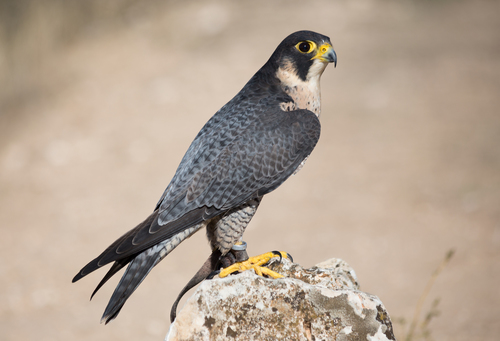
Peregrine Falcon
The Peregrine Falcon (Falco peregrinus) is a cosmopolitan bird of prey renowned for its incredible speed, making it the fastest animal on Earth. Reaching speeds over 320 km/h (200 mph) during its hunting stoop, this raptor is a symbol of power and agility. Peregrines play a crucial ecological role as apex predators, controlling populations of smaller birds. Historically, they have been prized in falconry and hold cultural significance in various societies, often representing freedom and nobility.
34-58 cm
Length
74-120 cm
Wingspan
Least Concern
Conservation Status
Distribution
Peregrine Falcons have one of the widest natural distributions of any bird. They are found on every continent except Antarctica, and inhabit a vast range of latitudes, from Arctic tundra to tropical rainforests. They are also found on many oceanic islands. Some populations are migratory, traveling vast distances between breeding and wintering grounds.
Lifespan
Up to 15 years in the wild, potentially longer in captivity.
Peregrine Falcon's Habitat
Habitat Types
Cliffs, Mountains, Coastal areas, Urban environments (skyscrapers, bridges), Open country, Wetlands
Climate Zones
Arctic, Temperate, Tropical, Subtropical
Adaptations
Peregrine Falcons are adapted to a wide range of habitats, demonstrating behavioral flexibility. Their exceptional eyesight allows them to spot prey from great distances. In urban environments, they have adapted to nesting on tall buildings, which mimic their natural cliff habitat.
Variations
Numerous subspecies of Peregrine Falcon exist, differing in size, coloration, and migratory behavior. Examples include the Arctic Peregrine (F. p. tundrius) and the Peale's Falcon (F. p. pealei) of the Pacific Northwest.
Appearance
Breeding Plumage
Adult plumage is generally consistent year-round.
Seasonal Feather Changes
Minimal seasonal variation in adult plumage.
Sex Based Plumage Differences
Males and females have similar plumage, typically slate-grey to blue-black upperparts and pale underparts with dark barring. Juveniles are browner.
Notable Features
Sharp, hooked beak for tearing prey., Powerful talons for grasping and killing prey., Dark 'malar stripe' or 'moustache' below the eye., Long, pointed wings for high-speed flight., Narial tubercles inside the nostrils to help withstand high speed air pressure during dives.
Diet and Feeding
Primary Foods
Birds (pigeons, doves, waterfowl, songbirds), Occasionally bats
Foraging Behavior
Peregrines primarily hunt by high-speed dives, or 'stoops,' striking prey in mid-air with clenched feet. They also hunt by pursuing prey in level flight or by capturing prey on the ground.
Specializations
Their exceptional speed and agility in flight, combined with keen eyesight, are key specializations for hunting. The narial tubercles are also a key adaptation.
Seasonal Diet Variations
Diet can vary seasonally depending on prey availability. Migratory populations may target different prey species along their migration routes.
Behavior
Social Structure
Generally solitary or found in pairs, except during migration when they may form loose aggregations.
Communication
Vocalizations, including 'kee-kee-kee' calls., Visual displays, such as bowing and head-low postures.
Migration
Many populations are migratory, traveling long distances between breeding and wintering grounds. Some populations are resident year-round.
Territorial or Group Behaviors
Peregrines are highly territorial during the breeding season, defending their nesting site from other raptors and potential predators.
Conservation
Threats
Historical use of pesticides (DDT) caused widespread population declines., Habitat loss and degradation., Collisions with human structures (buildings, power lines)., Persecution (illegal shooting, egg collection).
Protection Programs
CITES Appendix I (prohibits international trade)., Captive breeding and reintroduction programs., Legal protection in many countries., Habitat restoration and protection.
Local National Laws
Protected under the Migratory Bird Treaty Act in the United States and similar legislation in many other countries.
Population Trend
Increasing
Population Estimates
Difficult to estimate globally, but populations have recovered significantly since the mid-20th century.
Interesting Facts
The Peregrine Falcon is the fastest animal on Earth.
It can reach speeds over 320 km/h (200 mph) during its hunting stoop.
Peregrines have adapted to living in urban environments.
They nest on skyscrapers and bridges, which provide suitable nesting sites similar to cliffs.
Peregrine populations crashed in the mid-20th century due to pesticide use.
The pesticide DDT caused eggshell thinning, leading to reproductive failure.
They have a third eyelid, called a nictitating membrane.
It helps to protect and moisten the eye, especially during high-speed dives.
Faqs about Peregrine Falcon
What do Peregrine Falcons eat?
They primarily eat other birds, which they catch in mid-air.
Where do Peregrine Falcons live?
They are found on every continent except Antarctica, in a wide variety of habitats, including cliffs, mountains, and urban areas.
How fast can a Peregrine Falcon fly?
They can reach speeds over 320 km/h (200 mph) during their hunting dives.
Are Peregrine Falcons endangered?
They are currently listed as Least Concern by the IUCN, having recovered from near extinction in the mid-20th century.
Copyright @ Nature Style Limited. All Rights Reserved.
 English
English